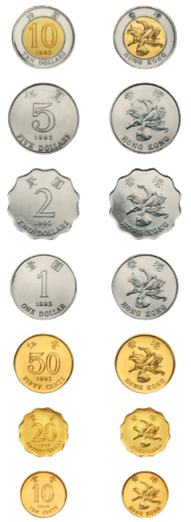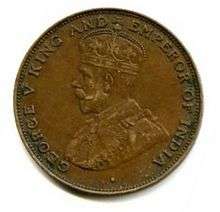Coins of the Hong Kong dollar
The Hong Kong coinage, including 10¢, 20¢, 50¢, $1, $2, $5 & $10, is issued by Hong Kong Monetary Authority on behalf of the Government of Hong Kong. From 1863 until 1992 these coins were embossed with the reigning British monarch's effigy. From January 1993 to November 1994, a new series depicting the bauhinia flower was gradually issued, including a new denomination of $10. Since the beginning of the coin replacement programme in 1993, over 585 million coins featuring Queen Elizabeth II have been withdrawn from circulation. However, these coins remain legal tender. The total value of coins in circulation in Hong Kong can be found in Monthly Statistical Bulletin and the Annual Report

Historical denominations
Discontinued denominations
The following coin denominations are no longer circulated by the HKMA.
- The 1 mill coin was discontinued due to its unpopularity.
- 1 cent last issued in 1934, but the last mintage which was melted down by the Japanese or lost was dated 1941.
- The 5 cent coin was last issued in 1979 and minted for uncirculated coin sets in 1988.
| Value | Diameter | Weight | Thickness | Edge |
|---|---|---|---|---|
| 1 mill 1863–1866 | 15 mm | 0.98 gr | 0.8 mm | Plain |
| 1 cent 1863–1926 | 27 mm | 7.53 g | 1.8 mm | Plain |
| 1 cent 1931–1941 | 21.5 mm | 4.05 g | 1.8 mm | Plain |
| 5 cent 1866–1935 | 15 mm | 1.34 g | 0.8 mm | Reeded |
| 5 cent 1937–1988 | 16.51 mm | 2.59 g | 1.73 mm | Reeded and reeded security edge. |
Denominations with specifications changed
The following current denominations that have changed in size, shape, and or metal content.
| Denomination | Details |
|---|---|
| One-cent coin | First issued in 1863, the one-cent copper coin had a larger diameter of 27.8mm. The same size was remained unchanged until 1902 when the coin was reduced in size to 22mm. |
| Five-cent coin | From 1866 to 1933, the five-cent coin was issued using silver. After the debasement of local coinage in 1933, the coin was then issued copper-nickel, and later nickel-brass in 1949 until its final issue in 1988. |
| Ten-cent coin | The ten-cent coin was first issued as a circular coin in 0.800 fineness silver in 1866. The overall design was changed in 1975, becoming a scallop-shaped nickel-brass coin. |
| Twenty-cent coin | The twenty-cent coin was first issued as a circular coin in 0.800 fineness silver in 1866. The overall design was changed in 1975, becoming a scallop-shaped nickel-brass coin. It has the same history s the ten-cent coin. |
| Fifty-cent coin | First issued by the Hong Kong government in 1866, the fifty-cent coin contains 90% silver with a diameter of 32mm. During the reign of George VI, copper-nickel coins were issued where the diameter was reduced to 23.5mm. In 1977, a nickel-brass coin with a similar design was issued, except for the further reduced diameter. |
| One-dollar coin | The dollar coin experienced three stages of change. First issued in 1866, it was minted in 90% silver with 38mm diameter. Subsequent changes were made in 1960, where copper-nickel coins with a diameter of 29.8mm were issued. The latest design was issued in 1978 where the diameter was further reduced to 25.5mm. |
| Five-dollar coin | The first series of decagon shaped five-dollar coin was issued in 1976. Yet, as it was easily counterfeited during that era, the colonial government decided to change the design of the five-dollar coin to a circle-shaped design with security edge starting 1980. |
Coins in circulation before 1997

King George VI series (1937–1951)

Queen Victoria series (1866–1901)
King Edward VI series (1902–1910)
King George V series (1911–1936)Queen Elizabeth II series (1952–1993)
| Queen Elizabeth II Series | ||||
|---|---|---|---|---|
| Value | Description | Date of | ||
| Obverse | Reverse | first minting | issue | |
| 10¢ | King George VI, "KING GEORGE THE SIXTH" | Value, title of the country, year of minting | 1948 | |
| 10¢ | Queen Elizabeth II, "QUEEN ELIZABETH THE SECOND" | 1955 | ||
| 20¢ | 1975 | |||
| 50¢ | King George VI, "KING GEORGE THE SIXTH" | Value, title of the country, year of minting | 1951 | |
| 50¢ | Queen Elizabeth II, "QUEEN ELIZABETH THE SECOND" | Value, title of the country, year of minting | 1958 | |
| $1 | Queen Elizabeth II, "QUEEN ELIZABETH THE SECOND" | Crest in the Coat of Arms of Hong Kong, value, title of the country, year of minting | 1960 | |
| $2 | 1975 | |||
| $5 | 1976 | |||
| $5 | Value, title of the country, year of minting | 1980 | ||
Coins in circulation since 1997
Since the introduction of Octopus card in 1997, small value payments and purchases in Hong Kong are mostly done as Octopus transactions. The Hong Kong Monetary Authority from 1998 to 2011, stopped issuing new coinage as the territory had stored enough for use. In 2012, the Hong Kong Monetary Authority resumed the minting of coins of the Bauhinia series after 14 years of non-minting of circulating coins, due in part of increased consumption for coins since 2004 in the territory.[1]
The obverse of each newest coin bears the standard bauhinia, with the word "Hong Kong" in Chinese characters and English. The reverse features the denomination in Chinese characters and English with a large Arabic numeral in the centre and the year of issue below.
| Bauhinia Series (since 1993) | ||||
|---|---|---|---|---|
| Value | Description | Date of | ||
| Obverse | Reverse | first minting | issue | |
| 10¢ | Bauhinia, "HONG KONG" | Value, year of minting | 1993 | May 1994 |
| 20¢ | October 1993 | |||
| 50¢ | ||||
| $1 | Bauhinia, "HONG KONG" | Value, year of minting | 1993 | October 1993 |
| $2 | January 1993 | |||
| $5 | ||||
| $10 | Bauhinia, "HONG KONG" | Value, year of minting | 1993 | November 1994 |
Commemorative coins and coin sets
Commemorative coins issued before 1997
- Lunar Zodiac Animal coin set, 1976–1986
- Royal Visit, 1975
- Royal Visit, 1986
- Proof Coin Collection, 1988
Commemorative coins issued after 1997
Opening of the Lantau Link, May 1997
To mark the opening of the Lantau Link, the HKMA issued a philatelic numismatic cover in May 1997, the first of its kind in Hong Kong. The Lantau Link is the first road link between Lantau Island, where the new airport is located, and the rest of Hong Kong.
Establishment of the Hong Kong Special Administrative Region, July 1997
To commemorate the establishment of the Hong Kong Special Administrative Region on 1 July 1997, the HKMA, on behalf of the Government, issued a HK$1,000 commemorative proof gold coin, 97,000 proof sets and an unknown number of brilliant uncirculated set of seven coins with the same denominations as the coins currently in circulation. On the obverse side of each of these seven coins is the standard Bauhinia design, with a special commemorative design and denomination on the reverse.[2]
Opening of the Hong Kong International Airport, July 1998
To mark the opening of the Hong Kong International Airport in July 1998, 15,000 $1,000 commemorative proof gold coin was issued. The gold coin features a design symbolising Hong Kong's ascent into the new century and bears the standard Bauhinia design on the obverse side.
The Five Blessings Commemorative Coin Set, February 2002
To mark the fifth year of the establishment of the Hong Kong Special Administrative Region, the HKMA, on behalf of the Government, issued 60,000 limited edition coin set that consists of five HK$50 silver coins with a gold-plated inner core, and a 9999 pure gold medallion. The five silver coins are individually engraved with a phrase and symbol of traditional blessing.
Security features
The $10 coin is made of two metals: a white nickel alloy outer ring and a brass inner core. The standard bauhinia on the obverse gives a sharp embossed image. The neat bonding between the outer and inner rings gives it another unique feature. The $10 coin has an alternate plain and milled edge. The $5 coin has a milled edge. A groove running within the milled edging contains raised English and Chinese characters, which read "Hong Kong Five Dollars". The $1 and 50¢ coins have simple milled edges. The $2 and 20¢ coins have scalloped edges. The 10¢ coin has a plain edge. Under Hong Kong law (sections 98 – 102 of Cap. 200), anyone who makes or possesses or controls or passes any counterfeit note or coin commits an offence and is liable on conviction to imprisonment for up to 14 years.
Adopted from the official website of Hong Kong Monetary Authority. Permission granted.
Coins sources
List of mints that issued Hong Kong's coins in the past:[3]
- Royal Mint, London
- Royal Mint, Hong Kong branch
- James Watt and Company Soho, Birmingham
- R. Heaton and Sons Limited (now The Mint, Birmingham Limited)
- King's Norton Metal Company Limited
References
- "Hong Kong mints new batch of HK$5 coins for first time in 14 years". South China Morning Post. 2 October 2012.
- "HKMA" (PDF).
- "Archived copy". Archived from the original on 15 August 2015. Retrieved 13 February 2013.CS1 maint: archived copy as title (link)
- Ma Tak Wo, 2004. Illustrated Catalogue of Hong Kong Currency, Ma Tak Wo Numismatic Co., LTD. Kowloon, Hong Kong.ISBN 962-85939-3-5
- Anthony Lee, 2008. Hong Kong Coins Guide (李漢民: 香港錢幣目錄), Collectables AL, Hong Kong.